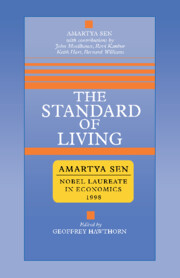Book contents
- Frontmatter
- Contents
- List of contributors
- Introduction
- The Standard of Living: Lecture I, Concepts and Critiques
- The Standard of Living: Lecture II, Lives and Capabilities
- Professor Sen on the Standard of Living
- The Standard of Living: Uncertainty, Inequality and Opportunity
- Commoditisation and the Standard of Living
- The Standard of Living: Interests and Capabilities
- Reply
- Bibliography
- Index
The Standard of Living: Lecture II, Lives and Capabilities
Published online by Cambridge University Press: 23 December 2009
- Frontmatter
- Contents
- List of contributors
- Introduction
- The Standard of Living: Lecture I, Concepts and Critiques
- The Standard of Living: Lecture II, Lives and Capabilities
- Professor Sen on the Standard of Living
- The Standard of Living: Uncertainty, Inequality and Opportunity
- Commoditisation and the Standard of Living
- The Standard of Living: Interests and Capabilities
- Reply
- Bibliography
- Index
Summary
There are two major challenges in developing an appropriate approach to the evaluation of the standard of living. First, it must meet the motivation that makes us interested in the concept of the living standard, doing justice to the richness of the idea. It is an idea with far-reaching relevance, and we cannot just redefine it in some convenient but arbitrary way. Second, the approach must nevertheless be practical in the sense of being usable for actual assessments of the living standard. This imposes restrictions on the kinds of information that can be required and the techniques of evaluation that may be used.
These two considerations — relevance and usability — pull us, to some extent, in different directions. Relevance may demand that we take on board the inherent complexities of the idea of the living standard as fully as possible, whereas usability may suggest that we try to shun complexities if we reasonably can. Relevance wants us to be ambitious; usability urges restraint. This is, of course, a rather common conflict in economics, and while we have to face the conflict squarely, we must not make heavy weather of it.
MEASUREMENT AND MOTIVATION
In fact, that conflict was well understood by the pioneers of the subject. It is fair to say that the discipline of statistical measurement of the living standard began with Sir William Petty and his book Political Arithmetick, written around 1676, but published posthumously in 1691. Petty's interests were wide. He was Professor of Anatomy at Oxford and Professor of Music at Gresham College. He invented the ‘double-bottomed’ ship, which alas was lost in a storm.
Information
- Type
- Chapter
- Information
- Tanner Lectures in Human ValuesThe Standard of Living, pp. 20 - 38Publisher: Cambridge University PressPrint publication year: 1987
Accessibility standard: Unknown
Why this information is here
This section outlines the accessibility features of this content - including support for screen readers, full keyboard navigation and high-contrast display options. This may not be relevant for you.Accessibility Information
- 75
- Cited by
